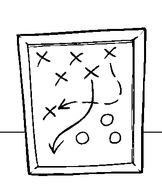
Chapter 2
You Gotta Know the Laws
In This Chapter
➤ Laws on race, religion, and national origin
➤ Laws on gender, pregnancy, and family issues
➤ Laws on age discrimination
➤ Understanding affirmative action
➤ The Americans with Disabilities Act
As a manager, the laws governing employment affect most of the decisions you make about the way you hire, supervise, compensate, evaluate, and discipline personnel. It begins even before your first contact with an applicant and governs all your relations with employees: how you screen candidates, what you pay employees, how you treat employees on the job—all the way to employees’ separation from the company, and sometimes even after that. This chapter looks at these laws and discusses some of the problems you might have in applying them in your job. It explores some of the problems that have plagued other employers and what you can do to avoid similar troubles.
The Civil Rights Act of 1964
The primary law in this area is the Civil Rights Act of 1964, as amended, which prohibits discrimination in employment on the basis of race, color, sex, religion, or national origin. The section of the law that covers employment (Title VII) is usually referred to as the Equal Employment Opportunity (EEO) law and is administered by the Equal Employment Opportunity Commission (EEOC). All companies or organizations with 15 or more employees are subject to this law. The EEOC also administers the Age Discrimination in Employment Act (ADEA) and the Americans with Disabilities Act (ADA).

Personnel Perils
In addition to federal employment laws, most states also have employment laws. In this book we’ll cover only federal laws. Make it a point to check with your attorneys or local authorities on special state laws that might affect you.

Tactical Tips
The interpretation of EEO laws comes from both administrative rulings and court decisions. As in many legal matters, what seems simple often is complex. It’s strongly recommended that you consult an attorney to clarify any actions you take to which these laws apply.
Discrimination—Race, Color, National Origin
Among the areas covered by Title VII of the federal Civil Rights Act of 1964 is the prohibition of discrimination on the basis of race, color, or national origin.
Although many states had already passed fair employment laws—some as far back as the 1940s—this was the first all-inclusive federal law to address this issue. Most companies recognize the importance of these laws and have made strong efforts to train and support staff to comply with them. Many large organizations have added equal employment officers to their human resources departments to be responsible for compliance with the laws. Smaller firms have assigned this responsibility to members of their management teams.
The Civil Rights Act made companies rethink and disregard many of the myths that kept them from hiring minorities. Such myths included the following:
➤ “White people will never work for a black supervisor.”
➤ “To have a harmonious department, employees should all come from the same ethnic group.”
➤ “You invite trouble if you put Poles and Germans, or Irish and Italians, or X’s and Y’s in the same unit.”
➤ “Blacks can do only menial work.”
However, the law changed more than just stereotypes. Practices and procedures such as the following had to be reconsidered:
➤ Questions on application forms and in interviews that directly or indirectly queried national origin had to be deleted (more on this in Chapters 7 and 8, “Screening Candidates” and “Becoming a Better Interviewer,” respectively).
➤ Employment tests that discriminated against minorities had to be eliminated or rewritten (see Chapter 9, “Making the Hiring Decision”).
➤ All employees who interviewed or processed applicants had to be trained to comply with the new laws and guidelines.
Religion
Prior to the passage of the Civil Rights Act, it was not uncommon for companies to refuse to hire people whose religious practices and beliefs differed from theirs. Help wanted ads often specified such requirements as “Protestants only,” and application forms included questions on religion. Such requirements were prohibited by the Civil Rights Act.
In addition to prohibiting religious discrimination in hiring, the law requires companies to make reasonable accommodation for a person’s religious practices unless doing so results in undue hardship on the company. This will be discussed further in Chapter 21, “Working with a Diverse Workforce.”

Meanings and Gleanings
According to the Equal Employment Opportunity Commission Guidelines, religious practices include not only traditional religious beliefs, but moral and ethical beliefs, and beliefs individuals hold “with the strength of traditional religious views.”
Gender, Pregnancy, and Family Issues
In addition to the prohibition of discrimination on the basis of race, religion, and national origin, the Civil Rights Act also prohibits discrimination on the basis of gender. Interestingly, when the Civil Rights Act of 1964 was introduced in Congress, it covered only race, color, religion, and national origin. An opponent of the act added sex discrimination to it because he believed that such a radical provision would make the law unpassable. As they say, the rest is history.

Meanings and Gleanings
Reasonable accommodation is the requirement for employers to adjust working conditions or schedules of employees to meet their religious needs or disability status. However, such accommodation is not required if it will cause the company undue hardship, usually defined as incurring excessive expense to make the accommodation.
Until the Equal Employment Opportunities laws, traditionally many jobs were associated with a particular gender. For the most part, skilled jobs such as carpentry, machining, and plumbing were considered suitable only for men (as were engineering, accounting, outside sales, and virtually all management positions). Women’s jobs usually were lower-paid positions such as nurses, typists, retail sales clerks, and low-skilled factory jobs.
Although there have always been exceptions, until this law was passed, few men were hired as secretaries and receptionists, and few women were hired or promoted to supervisory or management jobs. This law radically changed the gender structure of most companies. You now will find women in most type jobs and more men performing jobs that formerly were considered “women’s work.”
Bona Fide Occupational Qualifications
The gender provision of the EEO law, however, includes an additional element not found in the other categories. There are some positions for which a company is permitted to specify only a man or only a woman for the job. However, clear-cut reasons must exist for why a person of only that gender can perform the job. Within the law, these reasons are referred to as bona fide occupational qualifications, or BFOQs.

Meanings and Gleanings
A bona fide occupational qualification (BFOQ) exists when the gender of the employee is essential to performing the job. Some cynics have commented that the only undisputed bona fide occupational qualifications are a wet nurse (for a woman) and a sperm donor (for a man).
For example, if a job calls for heavy lifting, is it a BFOQ for men only? Not necessarily. There are women who have the capacity to do the job; there also are men who might not have the required strength. This can be determined by requiring that all applicants—both men and women—pass a weight-lifting test.
Additionally, let’s suppose a job calls for driving a forklift truck and that the operator is occasionally required to do heavy lifting. A woman applicant might be able to drive the truck but not be able to do the lifting. If the lifting is only a small part of the job, you cannot reject her. She is capable of performing the major aspect of the work, and other people can be assigned to handle the lifting.
Here’s another scenario: Suppose you have always had an attractive woman as your receptionist and the job is now open. Is being an attractive woman a BFOQ? Of course not. There’s no reason that a man—with the personality and skills for the position—cannot be just as effective.
Don’t Base Decisions on Stereotypes
Employers often have claimed that their policies on hiring women were not based on prejudice, but had sound business reasons. Women often have children at home and can’t travel, can’t work overtime, and typically stay home when a child is sick. The EEO laws do not recognize these as legitimate reasons to reject the application of a woman.
The sex discrimination provisions of the EEO laws also cover maternity and pregnancy. Although this was implied in the Civil Rights Act of 1964, it was clarified and strengthened by the Pregnancy Discrimination Act of 1978. The basic principal of this law is that women who are pregnant must be treated the same as other applicants and employees. In screening a pregnant applicant, she must be judged on her ability to perform the job for which she applies without regard to her current condition. The law also applies to current employees who might be terminated, denied benefits, or otherwise be penalized on the basis of their pregnancy or maternity.

Personnel Perils
Today, despite the laws, many employers still ask female applicants about their family responsibilities. In Chapter 8, you will learn what questions you may or may not ask and how to get the information you need lawfully.
You might be concerned that if you hire her, she will have to take time off for delivery and care of the infant, and perhaps will not even return to work. Under this law, you must assume that she will be away from the job for only a relatively short period of time. The law says that pregnancy should be considered the same as a “temporary disability.” There’s no question that it’s temporary and in most cases it will be only a minor inconvenience to the company.
Workplace Risks
There are some jobs in which working conditions such as exposure to certain chemicals might be dangerous to unborn children. Until just a few years ago, many companies had fetal protection policies that excluded pregnant women and sometimes all women of childbearing age from these jobs. The U.S. Supreme Court ruled that such policies were illegal and that women could not be barred from these jobs.
Lawyers specializing in employment law strongly recommend that when a woman is hired or later assigned to work in such a position, she be carefully informed about the workplace risks and be asked to sign a release. Because recent studies show that certain workplace substances can affect the male reproductive system, men hired or assigned to such jobs also should be informed of the risk and required to sign releases.
Age Discrimination
The Age Discrimination in Employment Act of 1967 prohibits discrimination against individuals 40 years of age or older. Additionally, some state laws cover all persons over the age of 18. Unlike the Civil Rights Act of 1964, which covers all employers with 15 or more employees, the ADEA applies to organizations with 20 or more employees.

Tactical Tips
When you interview older applicants, avoid the stereotypes that might keep you from hiring highly qualified people. Maybe you “can’t teach an old dog new tricks,” but people are not dogs and usually can be trained to do the job for which they apply. And they may know a few tricks themselves.
The original law protected only people between the ages of 40 and 65; companies could legally refuse to hire people over 65. This was changed by later amendments; now there is no maximum age. You may not refuse to hire an applicant so long as he or she is otherwise qualified even if that person is 100 years old. The law also prohibits mandatory retirement at any age with a few exceptions (for example, companies might require senior executives to retire at a specified age).
Note that the federal law does not apply to people under 40. Theoretically, you can turn down a 35-year-old applicant for being too old for your “trainee” job—but don’t try it. First, many states cover everybody over the age of 18. However, even if your state has not reduced the age, you can still get into trouble.
For instance, a few years ago a company rejected a 30-something applicant and told her they wanted a younger person for that position. She was advised that as she was under 40, she couldn’t file a complaint of age discrimination under federal law or in that state.
Here’s what happened: The State Job Service sent a 43-year-old applicant for an interview and when she was rejected, filed an age discrimination charge against the firm.
Even though most company application forms don’t ask a person’s age or date of birth and most people omit that information from their resumés, it’s still easy to guess an applicant’s age range within a few years. A team leader who prefers that young people join his or her team might overlook potential members who could be of great value to the team.
Affirmative Action
There’s no law that requires any company to give preference to members of a minority group. In fact, Title VII of the Civil Rights Act of 1964 (the Equal Employment Opportunity law) specifies that “nothing contained in this subchapter shall be interpreted to require any employer, employment agency, labor organization … to give preferential treatment to any individual or to any group because of the race, color, religion, sex, or national origin of such individual or group.”
So, why are so many companies practicing affirmative action? Some civil rights leaders assert that many discriminatory practices of the past remain so deeply embedded in basic institutions of society that they result in extreme exclusion of certain groups. This happens even when the employer has no conscious intent to discriminate. To help members of these groups catch up with the majority groups, these advocates suggested that affirmative action programs should be established. To meet this objective,
President Lyndon B. Johnson issued an executive order (#11246), which required not only special preference for certain minority groups, but an active program of affirmative action to recruit members of these “protected classes” into companies that held contracts with the government.
Who Is Covered? The “Protected Classes”
Executive Order #11246 requires affirmative action programs by all federal contractors and subcontractors that have contracts of more than $50,000 and have 50 or more employees. In addition to the organizations covered by the executive orders, any company that violates EEO laws might be required by the EEOC to establish an affirmative action program.
Although discrimination against all minority groups is illegal, only five groups have been designated as “protected classes.” They are as follows:

Meanings and Gleanings
An executive order is not a law. It is an edict promulgated by the president without being passed by Congress. Executive orders do not apply to the entire population—only to government agencies or organizations that do business with the government. Violation of an executive order can lead to cancellation of the government contract and debarment from future business with the government.
➤ Blacks This covers all individuals who are of African American background (however, in reporting, blacks of Hispanic background are listed under Hispanics).
➤ Hispanics This group includes all people who derive from countries in Latin America. (People from Spain are not considered “Hispanics,” they are considered “white” like other Europeans.)
➤ Asians or Pacific Islanders
➤ Native Americans or Alaskan natives
➤ Women
Determining the Numbers
Companies that are required to engage in affirmative action programs must hire members of each of the protected classes, in proportion to the population of people in each class within their communities. These numbers are based on figures issued by the Department of Labor and can be obtained from the Office of Contract Compliance, U.S. Dept. of Labor, Washington, DC, 20010.
Contractors then must survey their current work force to determine the number of employees in each category for each job classification. This is to set goals to bring into each job classification a representative group of people from all of the classes within the community. For example, a company might have a staff consisting of 40 percent black employees in a community where the African American population is 12 percent. The company is not in compliance because all of the black employees are in the lowest job classification. To comply, the company must take steps to bring more African Americans into higher-level jobs.

Management Miscellany
You don’t have to be in a protected class (black, Hispanic, Asian, Native American, or a woman) to file a charge of discrimination. Any person who believes his or her age, sex, race, ethnicity, disability, or religion has negatively affected him or her in obtaining or working on a job may take legal action.
The requirement for affirmative action applies only to the five protected classes noted in the preceding section. For example, even though 40 percent of your community are Italians, it is not necessary that 40 percent of your workforce be Italian. On the other hand, if Hispanics, Asians, blacks, or Native Americans make up 40 percent of the community you must strive to have 40 percent of that group in each level of your workforce. More difficult is determining standards for women. The Department of Labor bases this on the number of “women in the workforce” rather than women in general.
The Americans with Disabilities Act
The newest and probably least understood civil rights law is the Americans with Disabilities Act (ADA). Your company must adhere to this law if it has 15 or more employees. The ADA makes it illegal to discriminate in hiring, job assignments, and the treatment of employees because of a disability. Employers also must make reasonable accommodation so that disabled employees can perform the essential duties of their jobs. This accommodation can vary from building access ramps for wheelchair users to providing special equipment for people who are seeing- or hearing-challenged.
Reasonable accommodation for the disabled is required unless the accommodation will be an undue hardship for the company. Undue hardship usually is defined in monetary terms. If an applicant who uses a wheelchair applies for a job with a small company, the cost of building an elevator or a ramp to create access to the job location might be a financial hardship. If it is not possible to provide a less expensive accommodation, the company could reject the applicant. However, if the same applicant applies for a job in a more affluent company, it might not be considered undue hardship to do the necessary construction.
Accommodation doesn’t always require expensive construction. Here are some other ways to meet this requirement:
➤ The small company you work for wants to hire Gregory, an accountant who uses a wheelchair, but the accounting department is on the second floor of your building. The building has no elevator or ramp, and providing one would be an undue financial hardship for your company. However, there might be other ways to accommodate Gregory. Use your imagination. You could let him work on the ground floor or his work could be brought to him. It might be an inconvenience, but it would qualify as reasonable accommodation, and it would enable you to hire a particularly competent accountant.
➤ Dorothy, a highly skilled word processor operator, is legally blind and walks with the aid of a white cane. She can transcribe from dictated material faster and more accurately than many sighted people. You want to hire her, but you’re concerned that in case of a fire or other emergency she would be a danger to herself and others. The accommodation you can make is to assign someone to escort Dorothy in case of an emergency.
➤ Pete, an applicant for an assembler in a factory was badly injured in an automobile accident. The job requires him to stand at a workbench all day. Pete is unable to stand for long periods of time. Is this a legitimate reason to reject him? Accommodations can be made. Perhaps a high stool could be provided so that Pete could reach the workbench without having to stand. If that option isn’t feasible, the job structure could be changed so that he could work part time on that job and do other work that doesn’t require standing for long portions of the day.
Alcohol and Drug Users
Alcohol and drug users are considered disabled under the ADA. If a person can perform a job satisfactorily, a previous record of alcoholism or drug addiction is not reason enough to refuse hiring. However, if an applicant is still addicted and it resulted in poor attendance or poor performance in his or her previous job, you can reject the person—not because of the addiction, but because of poor work habits.
Most companies prohibit drinking on company premises or coming to work under the influence. If an employee violates this rule, he or she can be disciplined according to company rules. This may vary from just being sent home to a suspension or termination.
As using drugs is illegal in all states, companies have stricter rules on drugs. In most companies taking drugs on the job is a serious offense, and suspected drug users, even if they are not caught taking the drugs, may be required to be tested.
If you suspect that an employee cannot perform a job because of alcohol or drug abuse, have the person sent to the medical department. Drug testing is a medical procedure. Employees should be made aware that this policy will be enforced, and it should be clearly stated in the company’s policy manual.
Utilizing the Talents of Physically and Mentally Challenged People
Even in this day of computers and technological sophistication, many types of work are still routine and repetitious, resulting in high turnover among workers who are assigned to that work. Many companies have found that people who are mentally challenged can do this work and are not bored by it. These people often are capable of learning much more than you might expect.
Training the mentally challenged requires more patience and some tasks might have to be simplified; however, trainees who master these tasks retain the skills and often improve on them. Coaches who are specially trained to work with mentally challenged people are available in many communities. Your local mental health association can tell you whether this type of help is available in your area.
When you interview a candidate for a new job or consider someone for a promotion, don’t focus on disabilities. Concentrate on that person’s abilities. In this way you will not only give that person a chance to do his or her best on the job, but will give your department or company the opportunity to utilize the very best talents of all its people.
The Least You Need to Know
➤ The Civil Rights Act of 1964 prohibits discrimination in employment based on race, color, national origin, or sex.
➤ Women who are pregnant must be treated the same as other applicants and employees.
➤ The Age Discrimination in Employment Act of 1967 (ADEA) prohibits discrimination against individuals 40 years of age or older. Some state laws cover all persons over the age of 18.
➤ Companies that have government contracts of more than $50,000 and 50 or more employees must establish and implement an affirmative action program.
➤ The Americans with Disabilities Act makes it illegal to discriminate in hiring, in job assignments, and in the treatment of employees because of a disability.
..................Content has been hidden....................
You can't read the all page of ebook, please click here login for view all page.
